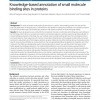57 search results - page 8 / 12 » Protein Annotation by Secondary Structure Based Alignments (... |
BMCBI
2010
13 years 7 months ago
2010
Background: The study of protein-small molecule interactions is vital for understanding protein function and for practical applications in drug discovery. To benefit from the rapi...
BMCBI
2007
13 years 7 months ago
2007
Background: Since many of the new protein structures delivered by high-throughput processes do not have any known function, there is a need for structure-based prediction of prote...
BMCBI
2007
13 years 7 months ago
2007
Background: Relating features of protein sequences to structural hinges is important for identifying domain boundaries, understanding structure-function relationships, and designi...
CIBCB
2005
IEEE
14 years 1 months ago
2005
IEEE
- Establishing structure-function relationships on the proteomic scale is a unique challenge faced by bioinformatics and molecular biosciences. Large protein families represent nat...
BMCBI
2008
13 years 7 months ago
2008
Background: For many types of analyses, data about gene structure and locations of non-coding regions of genes are required. Although a vast amount of genomic sequence data is ava...




